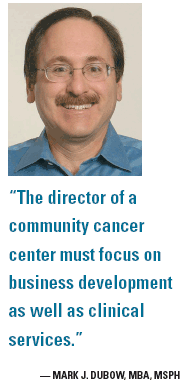Strategic planning in tough times calls for nimble thinking, viable plan of action
Despite dismal economic times, there are significant opportunities for growth for cancer centers, according to a presenter at the 2009 Association of Community Cancer Centers meeting.
WASHINGTON, DC-Despite dismal economic times, there are significant opportunities for growth for cancer centers, according to a presenter at the 2009 Association of Community Cancer Centers meeting.

Mark J. Dubow, MBA, MSPH, outlined some of the strategies that he recommends for weathering an economic maelstrom, including strategic initiatives, capital planning, innovation, and introduction of new products and services. All of these can mean the difference between a center’s financial and clinical success and the erosion of its income-producing patient services, said Mr. Dubow, who is a senior vice president at healthcare consulting firm The Camden Group. He is based in the El Segundo, Calif., office.
Opportunity in uncertain times
Recession, financial market turbulence, and economic unpredictability are currently playing havoc with the way cancer centers operate and with their prospects for the future. Financial pressure stems from reduced reimbursement, increased cost structure (including unfunded mandates), growing unemployment, and reduced access to capital. To add insult to injury, Medicare is establishing new and ever-more restrictive regulations.
But turbulence can create opportunity, Mr. Dubow said. He compared the current crisis to white-water rafting. “These are class 4 or 5 rapids-dangerous but navigable. Companies that are consistent leaders see that uncertain times are the best ones for an organization to take calculated risks and pursue growth.”
Strategy structure
Mr. Dubow explained that certain elements in strategy will always apply:
• Identify values. • Shape an organization’s vision.
• Set a course of action.
• Measure and monitor results.
• Assign responsibility.
These actions must be streamlined, according to Mr. Dubow: “If the process takes too long, the windows of opportunity close. Strategic planning must be accomplished in a month or less.” For executives who are used to the luxury of time to mull over blue-sky ideas, a month is a tight deadline, Mr. Dubow acknowledged. He identified a series of trends that drive cancer center strategy including:
• Assess trends in imaging such as increased utilization of lung CT and breast MRI, molecular risk profiling, and the consolidation of imaging centers.
• Recruit subspecialists in oncology interventional radiology. A cancer center’s growth and revenue can be boosted through the addition of interventional radiology suites.
• Recruit teams adept at robotic surgery, microsurgery, and stereotactic radiosurgery.
• Recruit medical, radiation, and surgical oncologists with tumor-specific expertise.
Tips for practice growth
While thinking outside the box has become a bit of a clich, achieving success in unstable times does require innovation. Mr. Dubow urged his audience to challenge long-held industry biases, such as the belief that physician-owned practices are not profitable.

He offered a punch list of ideas to increase patient volume and foster growth (see Sidebar). Ultimately, “there is no magic answer,” he said. “The director of a community cancer center must focus on business development as well as clinical services. Growth is a mindset as well as a process, and the director needs to have the courage to create change and envision new perspectives-and to do it quickly.”
Gedatolisib Combo With/Without Palbociclib May Be New SOC in PIK3CA Wild-Type Breast Cancer
December 21st 2025“VIKTORIA-1 is the first study to demonstrate a statistically significant and clinically meaningful improvement in PFS with PAM inhibition in patients with PIK3CA wild-type disease, all of whom received prior CDK4/6 inhibition,” said Barbara Pistilli, MD.